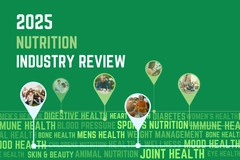
- Industry news
Industry news
- Category news
- Reports
- Key trends
- Multimedia
Multimedia
- Journal
- Events
- Suppliers
Suppliers
- Home
- Industry news
Industry news
- Category news
- Reports
- Key trends
- Multimedia
Multimedia
- Events
- Suppliers
Suppliers
TSI positions HMB as “missing supplement” for over 40s

13 Nov 2020 --- US-based health product manufacturer TSI is touting its formulation of hydroxymethylbutyrate (HMB) as the missing ingredient in nutrition supplements targeting muscle health in the 40-and-over age group.
As people enter middle age, maintaining healthy muscles becomes increasingly important. Research emphasizing the benefits of proper supplementation has previously been highlighted as a lucrative market for the nutrition industry.
“Most adults start losing muscle mass in their 30s, and all adults will experience muscle loss over time. It’s important to be highly proactive with muscle health nutrition to minimize the loss of muscle, strength and function associated with aging,” Lisa Pitchford, MTI biotech physiology researcher for TSI, tells NutritionInsight.
She adds that adults over 40 may also find it harder to recover from workouts or other physically taxing activities.
HMB in clinical trials
Results of a year-long randomized, double-blind, placebo-controlled study found that healthy older adults who supplemented their diets with HMB plus vitamin D3 (HMB+D) experienced improved muscle function, even without exercise.
The study, published in The Journals of Gerontology, showed that those taking HMB+D reported feeling more active and energetic. “While HMB+D does not replace exercise, it can help fill certain lifestyle gaps by helping to protect and even improve muscle health,” explains Pitchford.
The ingredient works by boosting protein synthesis and reducing protein breakdown. This “dual action” is particularly essential for the over 40s market as its effect on the muscular system can “protect against aging, poor diets and inactivity-associated muscle loss,” she notes.
Adding vitamin D to the ingredient was also shown to be essential in achieving muscle gains for the elder age range.
The reduction in protein breakdown is a major finding, according to the company. “HMB’s most unique benefit and where it shines over all other muscle health ingredients is in this ability,” says Larry Kolb, president of TSI.
For younger age ranges, it can serve a different purpose in aiding exercise performance by increasing recovery.
“Multiple clinical studies have shown HMB reduces exercise-induced muscle damage, reduces muscle soreness and also improves strength and recovery.”
.jpg) Muscle mass declines consistently with age.Sports nutrition and weight loss
Muscle mass declines consistently with age.Sports nutrition and weight loss
The findings implicate many important opportunities for sports nutrition and supplement product development, claims TSI.
The company has already patented a form of HMB specifically for products aimed at athletes.
“Our HMB Free Acid form, marketed under the brand myHMB Clear, is a newly developed, patented liquid form of HMB that offers increased absorption and performance. This liquid HMB form is ideal for use in drinks and shots. It’s a clear liquid and very easy to formulate into clear beverages,” says Kolb.
TSI aims to target younger markets, younger than 40, with this formulation for those looking to improve health and recovery.
“The active nutrition category is prime for innovation with HMB. This category represents a shift where consumers are focusing more on health rather than performance. Retaining muscle mass over time is a focus to help maximize muscle function, strength and longevity,” he explains.
Aiding weight loss
Another significant advantage of the ingredient is its ability to aid weight loss healthily.
“There is an emerging market for younger and middle-aged adults to use HMB while dieting,” says Kolb.
“HMB mitigates the loss of muscle during low calorie and calorie-restricted diets. HMB supplementation helps shift weight loss to fat rather than muscle. This improves overall body composition, metabolism and energy.”
 Adding vitamin D to HMB significantly improves muscle build in elderly people Formulation possibilities
Adding vitamin D to HMB significantly improves muscle build in elderly people Formulation possibilities
The ingredient can be formulated in numerous ways for different markets and purposes, according to Kolb.
“Both forms of HMB are very stable, making it easy to formulate. Customers are launching products in many product forms, including tablets, capsules, sachets and effervescents, drink mixes and gummies,” he explains.
Industry players are using HMB in these various formulations to reach different market areas.
“Our customers are targeting their launches to the primary, target consumer health applications. These include sports nutrition, active nutrition, healthy aging and medical nutrition,” continues Kolb.
The difficulties in bringing HMB to the market were chiefly a matter of formulating the ingredient into specific quantities and achieving quality tastes, he explains.
“The main challenges in creating products is finding product forms that deliver the efficacious dose of HMB (3 g per day) that are also well-tolerated and taste good, with high consumer compliance.”
“We developed multiple product prototypes with the best formulation houses in the industry. Doing the R&D work for our customers, in advance, rapidly advances the product development cycle and reduces time to launch,” concludes Kolb.
By Louis Gore-Langton











